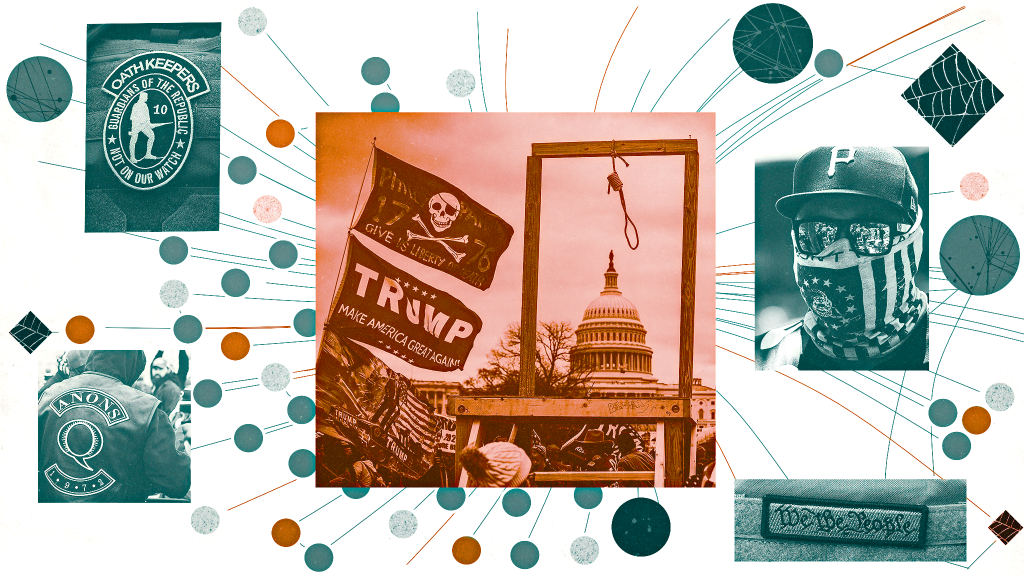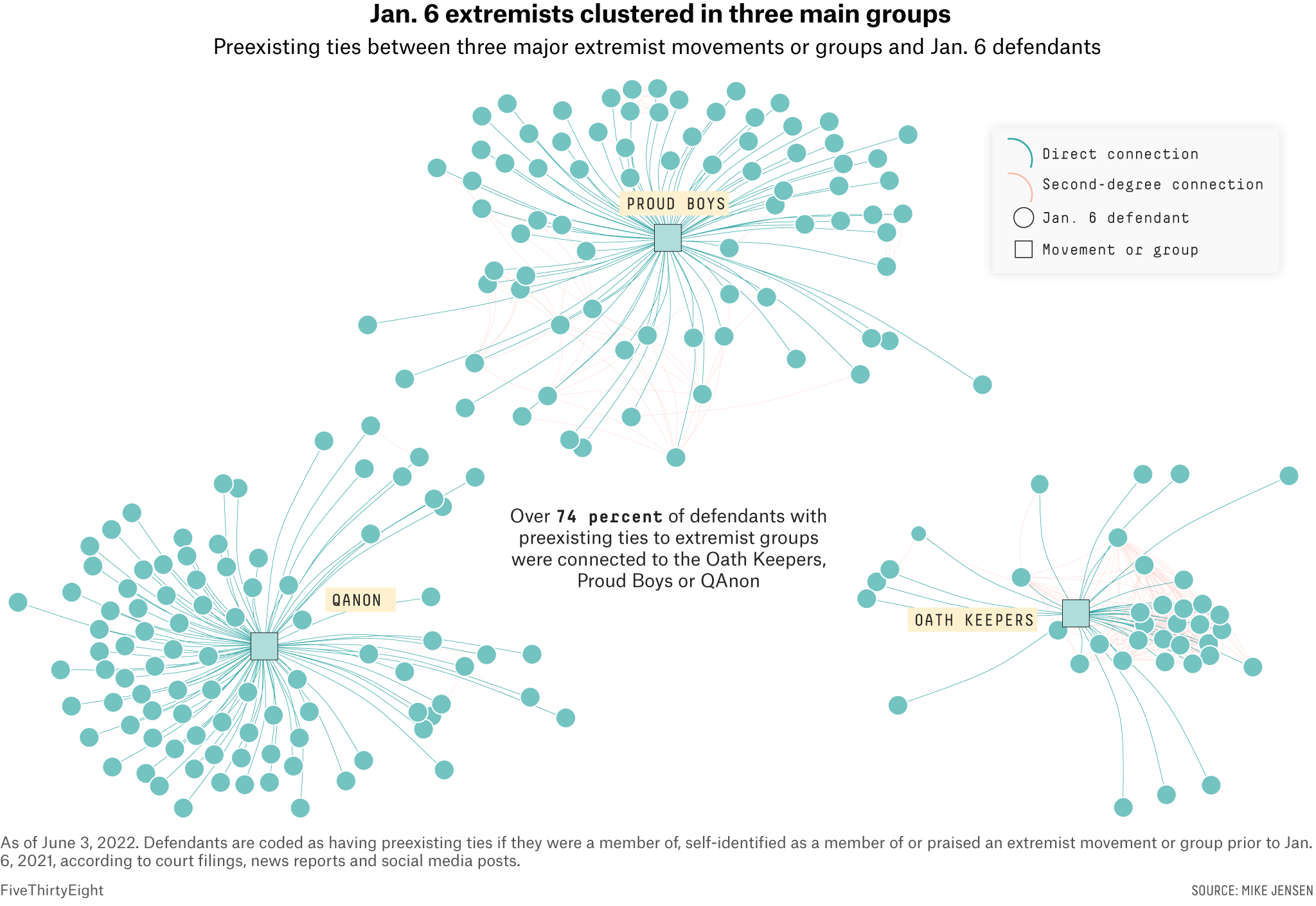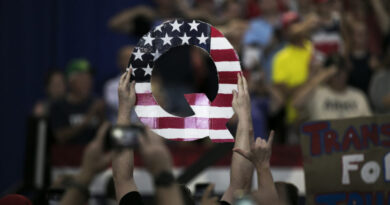Jan. 6’s Tangled Web Of Extremism

PHOTO ILLUSTRATION BY EMILY SCHERER / GETTY IMAGES
Mike Jensen keeps a database of bad guys. As a senior researcher at the University of Maryland’s National Consortium for the Study of Terrorism and Responses to Terrorism (START), part of Jensen’s job is to identify violent events that occur in the U.S. and investigate whether the people involved have any ties to extremism. If they do, he adds them to his database.
In what he calls a “very active” year, Jensen says he might end up adding 300 individuals to the database. But after the Jan. 6, 2021, attack on the U.S. Capitol, Jensen’s database grew dramatically.
“We have three times that on one day that potentially qualify,” Jensen said.
After the attack on the Capitol, Jensen started putting together a social network consisting of individuals who had been charged in relation to Jan. 6 and had existing ties to extremist organizations. He found many of the defendants had connections to extremist groups prior to Jan. 6, and that these groups were connected to one another. Relationships between defendants and a shared belief in the Big Lie forged new connections between these disparate groups. It’s not that your local Proud Boys chapter is regularly planning a bowling night with the neighborhood sovereign citizens collective. But when a lie about a stolen election aligns with their respective ideologies, they’ll be sure to show up in Washington, D.C., to riot together.
More than 800 individuals have been charged in relation to the Jan. 6 attack. To identify who had existing ties to extremist organizations, Jensen analyzed court filings, news reports and social media posts. He found roughly a third of those charged had preexisting ties to extremist groups<a class="espn-footnote-link" data-footnote-id="1" href="https://fivethirtyeight.com/features/jan-6s-tangled-web-of-extremism/#fn-1" data-footnote-content="
As of June 3, 2022. Jensen identified defendants as having extremist ties if they were a member of, self-identified as a member of, or praised an extremist group. He coded defendants as members if there was evidence that they had gone through a group’s established membership process, such as completing an application or paying dues. He coded defendants as praising or self-identifying with an extremist group if there was insufficient evidence that they had gone through the membership process despite expressing interest in joining; if the group or movement they praised does not have a membership process (like QAnon); or if they promoted the views of (i.e., publicly praised) the group. Public praise included publicly sharing or wearing the signs, symbols or slogans of a group or movement; publicly posting a movement’s ideology while attributing the ideas to said ideology; or sharing photos (including selfies) with group leaders or members.
“>1 and nearly one in five also had verifiable contact with other defendants prior to Jan. 6.
A photo of a defendant on social media sporting a Proud Boys T-shirt (a group that has a formalized membership) wasn’t enough to consider them a member of that group, nor was simply retweeting or liking a post from a member of that group, according to Jensen. He looked for more substantial connections, such as direct messages, posting on each other’s social media pages, or having a conversation in the comments or replies of social media posts.
Jensen’s data reveals a tangled web of individuals with connections to other defendants, as well as to a number of extremist groups including the Proud Boys (a far-right extremist group that is known for street violence and boasting about “Western chauvinism”), the Oath Keepers (a far-right anti-government militia) and QAnon, the wide-ranging conspiracy theory alleging that major Democrats and Hollywood figures are part of a secret cabal of Satanic pedophiles.

These extremist organizations look isolated in the chart above, but it’s only because we’ve removed most of the person-to-person connections. “Normally [these groups] would not get along. You would not have this coalition force. But on Jan. 6, what you saw is this perfect storm that brought together each of those distinct, disparate groups and movements, to act as one cohesive group in engaging in these actions,” said Jon Lewis, a research fellow at the Program on Extremism at George Washington University. Certain ideology — like the unfounded belief that the 2020 election was stolen from former President Donald Trump — can thread together otherwise disparate groups of extremists on the right, and can mobilize members of these groups to act collectively. When this happens, a single extremist organization can reach beyond its small sphere of influence, and it can lead to deadly results, as we saw on Jan. 6.
Here’s what it looks like when all the extremist defendants’ connections are visible:

In this database, Jensen has documented over 750 unique connections between defendants and between defendants and various groups. The resulting network is densely filled with connections between national leaders and lesser-known members of extremist groups. To understand how to parse it, let’s consider a couple of examples.
At the time of the Jan. 6 attack, Enrique Tarrio was the national leader of the Proud Boys and Stewart Rhodes was the leader of the Oath Keepers. Unsurprisingly, these two individuals are found basically at the center of the web. Both the Proud Boys and the Oath Keepers had a large presence on Jan. 6, and the groups have been accused of plotting and coordinating ahead of the attack. Though Tarrio wasn’t at the Capitol on Jan. 6, he is alleged to have been coordinating the Proud Boys movements from Baltimore, and to have helped plan the attack ahead of time. Both Rhodes and Tarrio were recently charged with seditious conspiracy (among other charges), a federal charge punishable by up to 20 years in prison. We reached out to Rhodes’s and Tarrio’s lawyers. Rhodes’s lawyer did not respond to a request for comment. Tarrio’s lawyer, Nayib Hassan, called the notion that the Proud Boys and the Oath Keepers were connected a “fictious lie” and referred to a motion filed in the case disputing claims that the two organizations coordinated ahead of the attack.
In the chart below, you can see how Tarrio and Rhodes link the different points in the web together. Through dozens of other defendants from whom they are separated by one or two degrees, Tarrio and Rhodes connect almost three-quarters of the known extremist organizations that were present on Jan. 6:

But it’s not only the leaders of national right-wing extremist groups who were heavily connected prior to the attack. Let’s highlight two other individuals: Dominic Pezzola and Charles Donohoe. Both Pezzola — a 45-year-old small business owner from Rochester, New York — and Donohoe — a 34-year-old handyman from the suburbs outside Winston-Salem, North Carolina — were members of the Proud Boys. At the time of the attack, Donohoe was a chapter president in North Carolina, while Pezzola was a somewhat new but active member in New York. Though not national figures, both men were allegedly members of the “Ministry of Self Defense,” or MOSD — a chapter of the Proud Boys’ inner circle that planned national rallies. According to court filings, Donohoe was also a member of the MOSD Leaders Group, a chat group that was allegedly created by Tarrio where members of MOSD planned the Proud Boys participation on Jan. 6. Donohoe also has a connection to QAnon — he provided security for a QAnon “save the children” rally in Fayetteville, North Carolina, in August 2020.
Largely through their membership in these chat groups, even these lower-level Proud Boys end up deeply integrated into this web. Donohoe has direct contact with six other named defendants, while Pezzola has direct contact with eight others.<a class="espn-footnote-link" data-footnote-id="2" href="https://fivethirtyeight.com/features/jan-6s-tangled-web-of-extremism/#fn-2" data-footnote-content="
Including one another. Calculated as degree, which is the number of individuals that Jensen confirmed a person interacted with directly.
“>2 While Donohoe has many connections with other groups and quite a few direct connections to other defendants, Pezzola is one of the main links between highly connected defendants and defendants who have relatively few connections.<a class="espn-footnote-link" data-footnote-id="3" href="https://fivethirtyeight.com/features/jan-6s-tangled-web-of-extremism/#fn-3" data-footnote-content="
Calculated as betweenness centrality, the number of shortest paths between everyone in the network that includes the person of interest. Betweenness can be interpreted as how many indirect connections exist because a specific person links them together.
“>3

Think of it like a chain of people holding hands. On one end, you have the Proud Boys, and on the other end, you have the Oath Keepers. In the middle of that chain is Pezzola, one of the links connecting the two groups. We reached out to the lawyers for both Pezzola (who has pleaded not guilty) and Donohoe (who has pleaded guilty). Pezzola’s lawyer did not respond to follow-up requests for an interview. Donohoe’s lawyer, Ira Knight, sent a statement: “Charlie regrets his actions, and is remorseful for the conduct that led to these charges. He has accepted responsibility for his wrongs, and is prepared to accept the consequences.”
The attack on the Capitol was the culmination of shared ideology — in this case, the belief in Trump’s false claims of a stolen election — mobilizing disparate groups into action. Soon after the attack on the Capitol, prosecutors claimed that extremist groups like the Proud Boys and the Oath Keepers had coordinated ahead of Jan. 6. The alleged coordination and the relationships captured in Jensen’s data demonstrate how that shared ideology forged new connections between these groups.
“It’s really narratives that the bigger, radicalizing, conspiratorial networks can capitalize on at any given moment to facilitate offline organizing,” said Samantha Kutner, a researcher at the Khalifa Ihler Institute, a Sweden-based think tank that focuses on ending extremism worldwide. Kutner has conducted extensive research on the Proud Boys.
Jensen said he has a list of individuals with extremist ties who were at the Capitol on Jan. 6 but aren’t in his database yet because they haven’t been formally charged. If and when that happens, he says the web will only become more entangled. What’s most troubling about this web, he said, is that the kind of ideas that link and can mobilize these groups are becoming more commonplace. He said it’s the popularization of those ideas that should be raising alarm bells, more so than any individual group’s actions or organization.
“We’re in an environment right now in this country where we are so politically divided and polarized that almost everything now seems like a mobilizing event,” Jensen said. “I think we’re going to see more of that.”
This article has been archived for your research. The original version from FiveThirtyEight can be found here.






